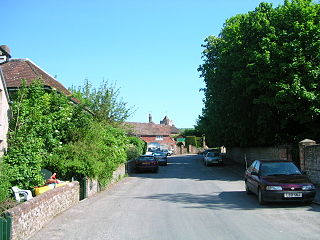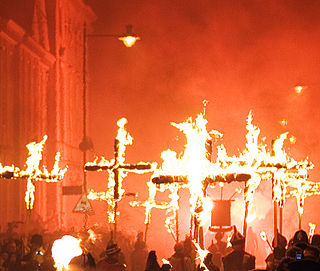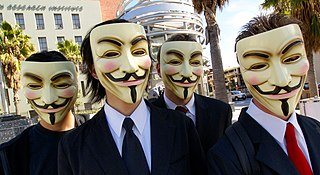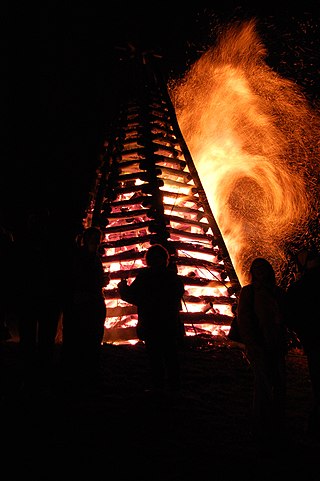
Guy Fawkes, also known as Guido Fawkes while fighting for the Spanish, was a member of a group of provincial English Catholics involved in the failed Gunpowder Plot of 1605. He was born and educated in York; his father died when Fawkes was eight years old, after which his mother married a recusant Catholic.

Lewes is the county town of East Sussex, England. The town is the administrative centre of the wider district of the same name and the location of East Sussex County Council at the county hall.

Newhaven is a port town in East Sussex in England, lying at the mouth of the River Ouse.

The Bluebell Railway is an 11 mi (17.7 km) heritage line almost entirely in West Sussex in England, except for Sheffield Park which is in East Sussex. It is managed by the Bluebell Railway Preservation Society. It uses steam trains which operate between Sheffield Park and East Grinstead, with intermediate stations at Horsted Keynes and Kingscote.

Crowborough is a town and civil parish in East Sussex, England, in the Weald at the edge of Ashdown Forest in the High Weald Area of Outstanding Natural Beauty, 7 miles (11 km) south-west of Royal Tunbridge Wells and 33 miles (53 km) south of London. It had a population 20,607 at the 2011 Census.

Guy Fawkes Night, also known as Guy Fawkes Day, Bonfire Night and Fireworks Night, is an annual commemoration observed on 5 November, primarily in Great Britain, involving bonfires and fireworks displays. Its history begins with the events of 5 November 1605 O.S., when Guy Fawkes, a member of the Gunpowder Plot, was arrested while guarding explosives the plotters had placed beneath the House of Lords. The Catholic plotters had intended to assassinate Protestant king James I and his parliament. Celebrating that the king had survived, people lit bonfires around London; and months later, the Observance of 5th November Act mandated an annual public day of thanksgiving for the plot's failure.

Candy apples are whole apples covered in a sugar candy coating, with a stick inserted as a handle. These are a common treat at fall festivals in Western culture in the Northern Hemisphere, such as Halloween and Guy Fawkes Night because these festivals occur in the wake of annual apple harvests. Although candy apples and caramel apples may seem similar, they are made using distinctly different processes.

Lewes is a constituency in East Sussex represented in the House of Commons of the UK Parliament since 2015 by Maria Caulfield, a Conservative.

Firle is a village and civil parish in the Lewes district of East Sussex, England. Firle refers to an old-English/Anglo-Saxon word fierol meaning overgrown with oak. Although the original division of East Firle and West Firle still remains, East Firle is now simply confined to the houses of Heighton Street, which lie to the east of the Firle Park. West Firle is now generally referred to as Firle although West Firle remains its official name. It is located south of the A27 road four miles (9 km) east of Lewes.

Heathfield is a market town and former civil parish, now in the parish of Heathfield and Waldron, in the Wealden District of East Sussex, England. The town had a population of 7,732 in 2011.

Newick is a village, civil parish and electoral ward in the Lewes District of East Sussex, England. It is located on the A272 road six miles (9.7 km) east of Haywards Heath.

South Heighton is a village and civil parish in the Lewes District of East Sussex, England. The village is seven miles (12 km) south of Lewes. In the 1890s the village's population grew from less than 100 to over 500 after a cement manufacturing plant opened nearby. The village is now associated with the urbanised area of Newhaven.

The West Country Carnival Circuits are an annual celebration featuring a parade of illuminated carts in the English West Country. The celebration dates back to the Gunpowder Plot of 1605. The purpose is to raise money for local charities.

The Guy Fawkes mask is a stylised depiction of Guy Fawkes created by illustrator David Lloyd for the 1982–1989 graphic novel V for Vendetta. Inspired by the use of a mask representing Fawkes being burned on an effigy having long previously had roots as part of Guy Fawkes Night celebrations, Lloyd designed the mask as a smiling face with red cheeks, a wide moustache upturned at both ends, and a thin vertical pointed beard, worn in the graphic novel's narrative by anarchist protagonist V.

Lewes Bonfire, or Bonfire for short, describes a set of celebrations held in the town of Lewes, Sussex, England, that constitute the United Kingdom's largest and most famous Bonfire Night festivities, with Lewes being called the bonfire capital of the world.

Mark Antony Lower F.S.A. M.A. was a Sussex historian and schoolteacher who founded the Sussex Archaeological Society. An anti-Catholic propagandist, Lower is believed to have started the "cult of the Sussex Martyrs", although he was against the excesses of the "Bonfire Boys".

The Gunpowder Plot was a failed assassination attempt against King James VI of Scotland and I of England by a group of provincial English Catholics led by Robert Catesby. The conspirators' aim was to blow up the House of Lords at the State Opening of Parliament on 5 November 1605, while the king and many other important members of the aristocracy and nobility were inside. The conspirator who became most closely associated with the plot in the popular imagination was Guy Fawkes, who had been assigned the task of lighting the fuse to the explosives.
The Lewes Martyrs were a group of 17 Protestants who were burned at the stake in Lewes, East Sussex, England, between 1555 and 1557. These executions were part of the Marian persecutions of Protestants during the reign of Mary I.

Bonfire Night is a name given to various annual celebrations characterised by bonfires and fireworks. The event celebrates different traditions on different dates, depending on the country. Some of the most popular instances include Guy Fawkes Night in Great Britain, which is also celebrated in some Commonwealth countries; Northern Ireland's Eleventh Night, and 5 November in Newfoundland and Labrador. In various parts of Ireland, Bonfire Nights are held on Saint John's Eve, Bealtaine eve and Halloween. Up until 1959 it was illegal not to celebrate Guy Fawkes Night in the UK, which evolved into the Bonfire Night of today.



















